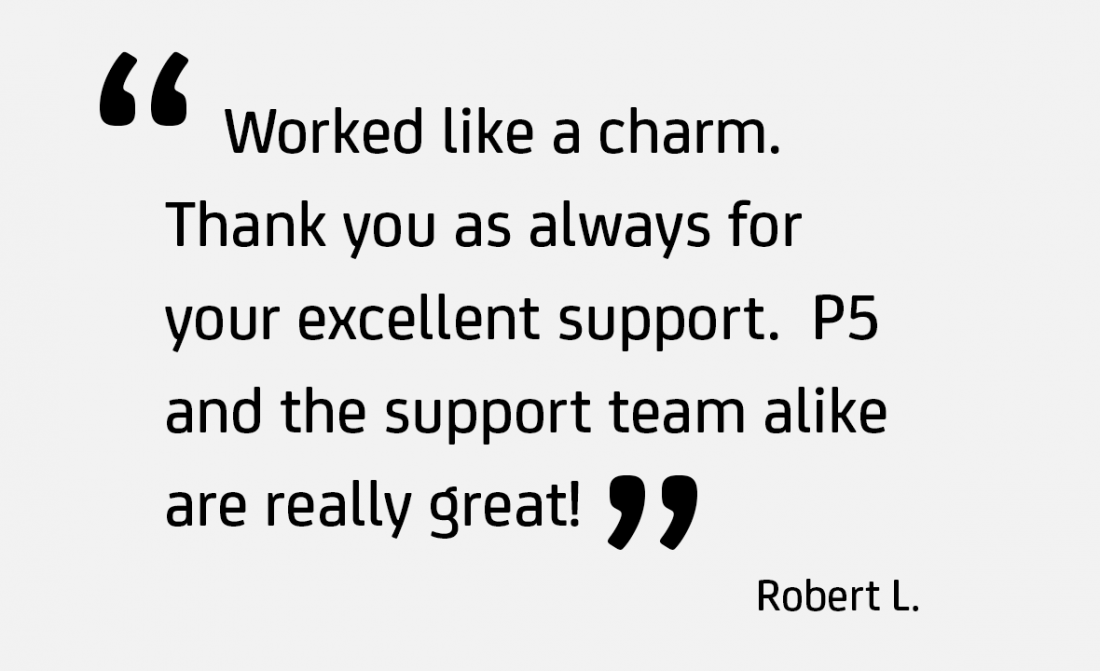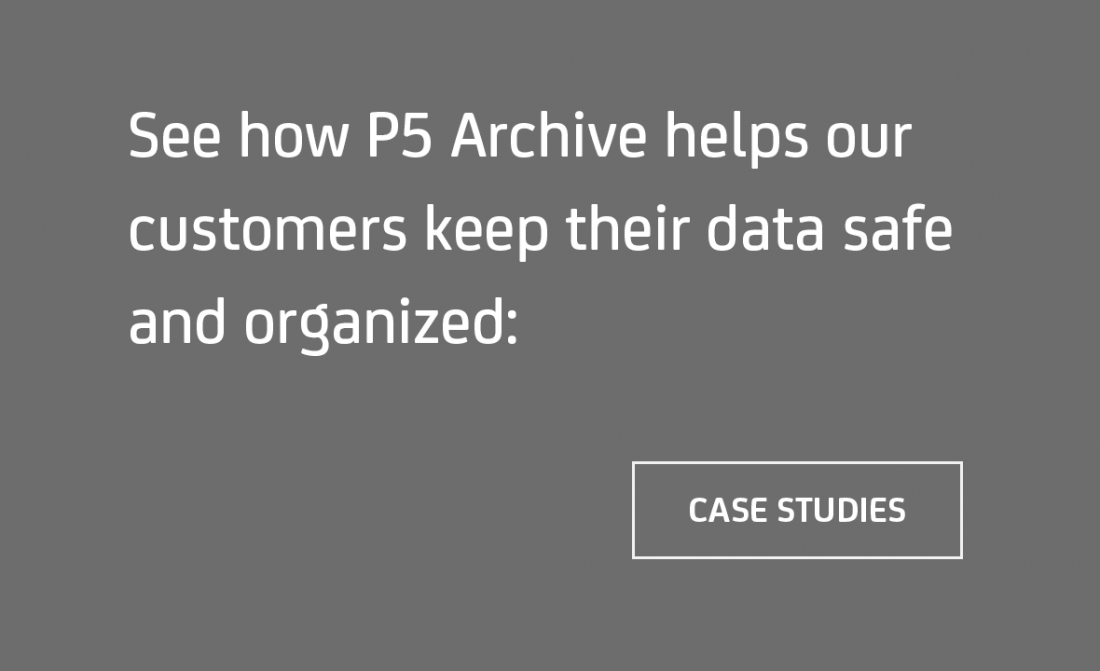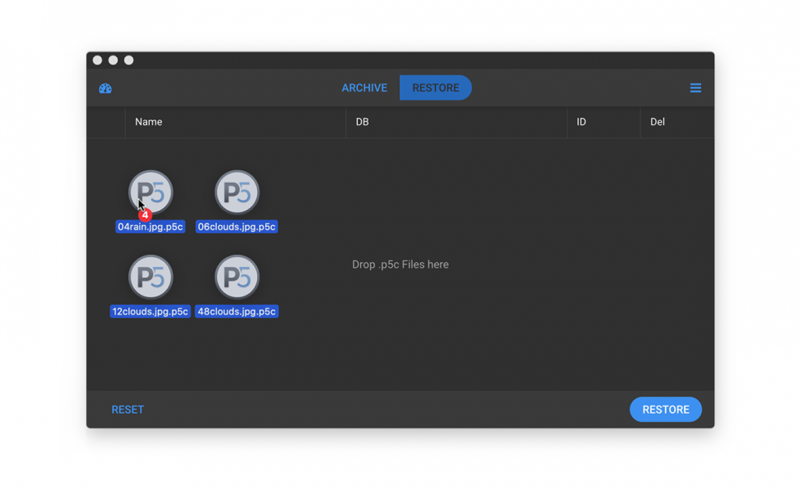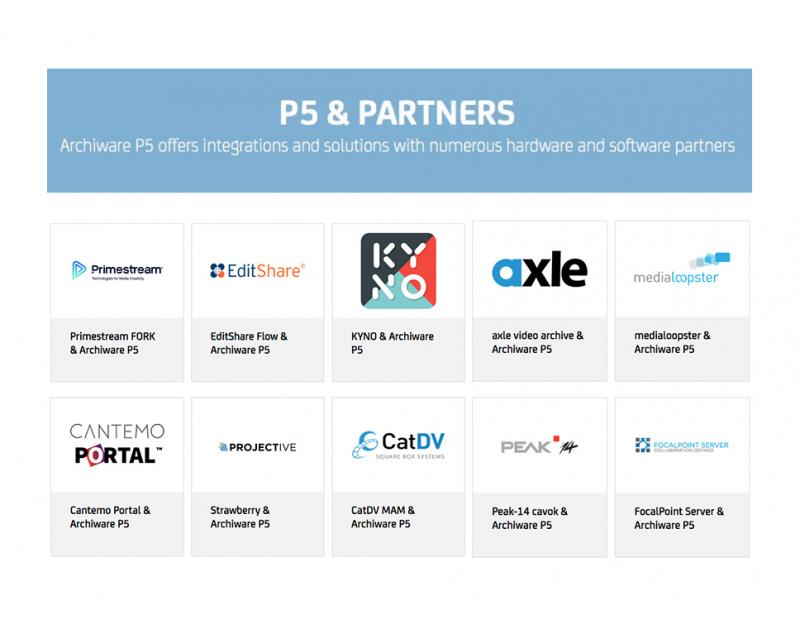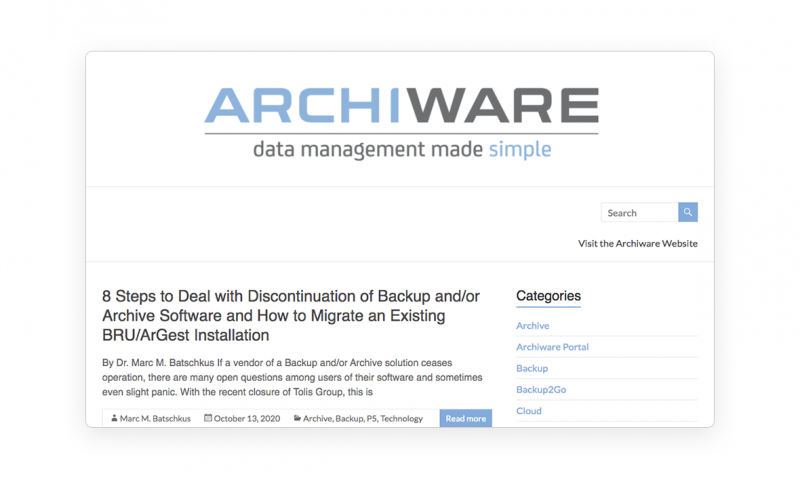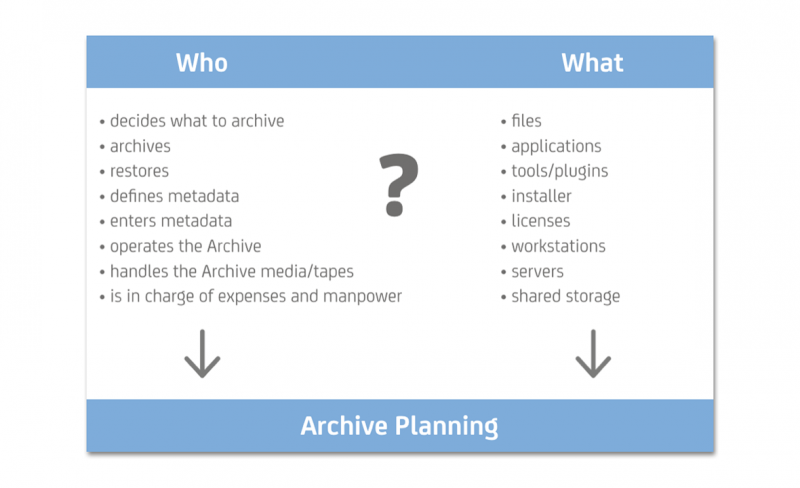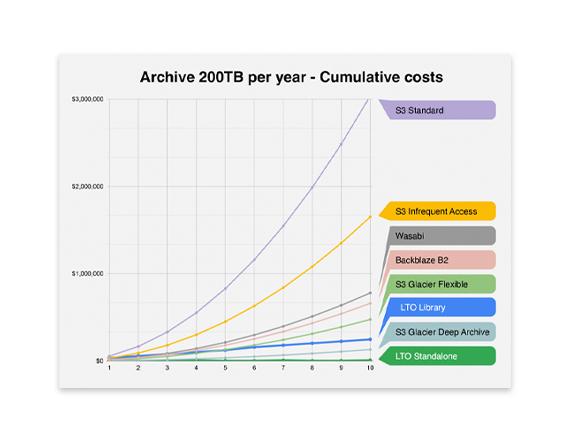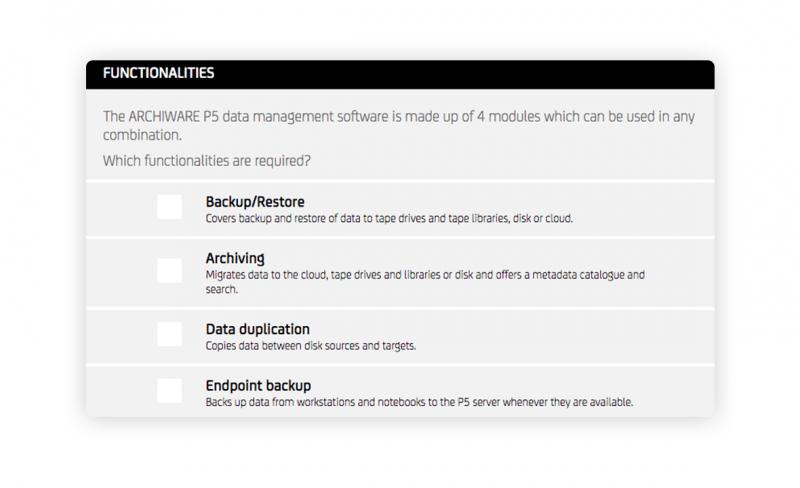Make Room for Tomorrow.
Migrate inactive data to cost effective archive storage.
P5 Archive is a long-term archive solution that moves data to disk, LTO/LTFS tape & the cloud
The P5 Archive software can be set up within minutes, and works cross platform on Mac, Linux, Windows, FreeBSD, Synology, QNAP, NETGEAR, and FreeNAS/TrueNAS. You can restore data on any platform since P5 stores it in a platform-neutral format.
- Browser interface
- Thumbnails and proxy clips
- Customisable metadata fields and menus
- Combined search, storable
- Storage agnostic: Disk, LTO/LTFS Tape and Cloud as target storage
- Mac, Windows, Linux, QNAP, Synology, NetGear, FreeNAS/TrueNAS
- Drag-and-Drop Archiving and Restore as option
- Project restore (EDL, OTIO, FCPXML, ALE)
- Policy-based moving, replicating and tiering of archived data with P5 Archive DLM
- LTO hardware encryption
- LTFS as archive format, import and export (ISO/IEC 20919:2016)
- Scales to PB and billions of files
Media Archiving Software Solution
Archiware P5 Archive software is a long-term archiving and media preservation solution. Archiware P5 offers a browser-based interface for quick and easy configuration, administration and monitoring – regardless of your location. The P5 Archive software offers multi-platform support of macOS, Windows, Linux, QNAP, Synology, FreeNAS/TrueNAS and NetGear for maximum flexibility of present setups and possible future platform changes.
P5 Archive helps to move data to cost-effective LTO/LTFS tape media. Single LTO drives, as well as LTO libraries of virtually all vendors, are supported. In the process, expensive production storage can be reclaimed, while the backup volume and runtime are reduced. Additionally relieving the network of traffic results in an improved working experience and increased productivity.
Archiving to Cloud storage is possible for Generic S3, Amazon S3, Amazon Glacier, Backblaze B2, Google Cloud, Hitachi S3, Microsoft Azure, Oracle Cloud, RSTOR Space, Seagate Live Cloud, Wasabi S3 and others. Access to Wasabi storage is built-in to P5. Manual configuration of the Wasabi end-point DNS names is not required. Archiving to the Cloud saves hardware and administration cost and the storage capacity can be extended on-demand.
As user requirements grow and change, P5’s modular design allows optimal scaling to fit your specific needs. Adding additional Archiware products is quick and easy. Hardware and media can expand when needed. P5 Archive can save data to disk, LTO tape and the cloud, while the same LTO hardware can simultaneously be used by P5 Backup.
Offsite Storage
P5 Archive lets you move or migrate data offline to disk, tape and the cloud. You can monitor files, folders and the directory structure to archive files automatically.
Fine-grained filtering can be applied to select or exclude files based on name, size, date etc. Data can be cloned to a second tape for offsite storage. Encryption options protect data against non-authorized access both during the transfer and on the media itself.
Easy Asset Management
P5’s archiving software can function as an easy to use asset management system, e.g. to manage video archives. Features include media previews and proxy clips, customisable metadata fields and menus. Visual browsing as well as combined searching helps to find and restore specific files even years after they were created.
An automatic backup of the Archive index provides maximum security for the operation of the archive. When switching between search results in the archive index and browsing, previously executed search is retained, easing location of the data you're looking for. Previous 10 searches are available from drop-down menu.
Free Choice of Storage
Which storage fits best depends on your requirements, budget and strategy. Each of the available storage categories - disk, tape and cloud - have their own specific characteristics and strengths. P5 Archive can use disk, tape and cloud storage to offer maximum flexibility.
Incremental Archive
P5 Archive allows data to be archived in incremental mode. This way, only new and changed files will be archived, effectively minimizing the growth of the Archive.
Very Fast Verification of Written Data
By using xxHash 64 and 128-bit algorithms, P5 speeds up the verification using checksums by 3x.
3rd Party Integrations
P5’s scriptable command line interface and REST-based API offer unlimited options for 3rd party integrations. The following options are already available: axle, CatDV, CANTEMO, Canto Cumulus, DALIM, EditShare, eMAM, FocalPoint Server, Helios, Kyno, medialoopster, Metus, Pomfort, Primestream, Projective, Streamline Pro, and Xinet.

Archiware P5 configurable dashboard.
Project Restore
This feature allows users to import project files such as EDL, OTIO, FCPXML, and ALE to automatically restore all referenced media from the archive. Ideal for offline, online, or proxy workflows and archive recovery, it also works with P5 inventory files for job wise imports. Smart search ensures media can be located even if file paths have changed, while bulk processing enables handling of hundreds of media references at once. Supporting multiple industry standard project file formats, the feature also allows users to preview and select which versions to restore before processing, streamlining project recovery and workflow efficiency.
LTO hardware encryption
AES 256 encryption is performed directly in the LTO drive, ensuring strong security without impacting performance. The feature integrates seamlessly into existing P5 Archive workflows and supports LTFS format tapes, providing protection against unauthorized access in case tapes are lost or stolen. This makes it particularly suitable for media companies handling sensitive client projects or needing to meet compliance requirements, with encryption applied automatically and transparently, requiring no changes to current archiving processes.
Import of Foreign LTFS Volumes
This feature brings huge benefits for users with data stored on LTFS tapes. Manage LTFS tapes by importing them into P5 Archive, they will appear in the index of your choice, with full search across all volumes.
Supports LTFS tapes written by P5 or 3rd party LTFS software. P5 will scan LTFS tape volumes, and add contents to the P5 archive index, data can then be restored across multiple tapes via the archive index. Supports tape libraries for import across multiple slots.
Media Hash List (MHL) checksum manifest of LTFS archived data
This feature allows to check that the source data has been saved and recovered without any alterations. It is available as an additional option of the LTFS External Volume Pool Configuration.

P5 Archive as basic asset management with previews and proxies.
S3 Object Archive
Behind the long name, lies an immensely powerful interface through which external products can access the power and flexibility of archival to LTO storage with Archiware P5 Archive. P5 Archive offers an S3 Object Storage service, presenting an S3 end-point for other software to connect to. Compatible with Amazon S3 Glacier Flexible & Deep Archive storage classes, objects received via the S3 interface are archived to LTO/LTFS, with full management of tapes, drives and libraries.
Third-party software solutions that manage data, such as MAM/DAM/PAM systems, have the ability to archive data with P5 Archive via their own S3 client interface. Any solution that can archive data to cloud services, and supports the 'glacier' storage class, can access LTO/LTFS storage.
Existing P5 Archive customers gain the option to receive external data via an S3 connection and better leverage their LTO investment. External cloud storage can be migrated to on-prem storage, S3 to S3, returning physical security and ownership.
Storage Buckets are configured within P5 for this purpose, each connected to a P5 storage pool, defining the target archive storage. P5 maintains an archive index for each bucket, tracking each archived file.
Future MAM/DAM/PAM integrations may wish to use this interface as an alternative to the existing P5 API's.
Archive Using Pool or Object Format
Pool Format
P5 Archive can migrate and archive data offsite using two options: the Pool or Object Format. The Pool Format includes all the familiar, powerful features of P5 (cloning, migration, etc.). This standard procedure assigns archived data to a Pool consisting of a flexible number of Volumes. The organization and bundling of data into Pools and Volumes creates manageable entities. In the Pool Format, data is exclusively restored through P5. Supported storage formats include tape, disk and the cloud. Native Microsoft Azure cloud storage support, along with Hitachi and Wasabi support, via the Generic S3 option are available when using the Pool format for cloud storage.
Object Format
The Object Format allows single-file access and share-ability for cooperative workflows. In this format, archived data are stored as individual objects (Files). This mode provides applications and users the option of directly accessing and restoring data archived to the cloud without P5. To enable direct data access, P5 stores data in its original format in the cloud. The link-addresses required for external access are logged by P5. This storage format is only supported in the cloud (Amazon S3, Backblaze, generic S3).
Server-Wide Incremental Archiving
P5 Archive has long supported incremental (INC) archiving of data, such that only new and changed files are added to the archive while files that are already archived are not added again. Customers commonly use this feature to archive changing production data on their storage through its lifecycle. A FULL archival of completed projects then allows final delivered projects to be preserved into the future.
An enhanced INC archive, called INC+ is able to track files that have already been archived, when they are moved into different locations and/or different storage volumes.
P5 Archive tracks each archived file by adding a unique identifier, using extended-attributes of the filesystem. It can then determine that a moved file is already saved in the archive and update its location in our index.
Tracking changing projects becomes more efficient, large amounts of data may be relocated without being re-saved by the archive - effectively de-duplicating the archive data at a file level.
Cloud Import/Export Services
Backblaze, Amazon and Microsoft all offer an upload service, whereby a physical storage appliance can be shipped to a location where data can be transferred locally using NAS/DAS protocols to the appliance and then into a cloud container when the disk is returned to the cloud vendor. This allows for larger dataset to be migrated to cloud storage without potentially slow transfers using public WAN connections.
P5 Archive allows such services to be used to bootstrap a cloud archive. The initial data requiring archive can be moved to the cloud using one of these storage appliances coupled with the service offered by the cloud vendor.
When seeding archive data using an AWS Snowball, B2 Fireball or similar, P5 provides a checkbox to suppress writing of data to the cloud object store directly.
LTFS Import/Export
The Linear Tape File System (LTFS) allows files to be stored on LTO tape and be accessed in a similar fashion to those on disk or removable flash drives. Since LTFS-formatted tapes can be used between different drives/software, they are a useful format for transfer of data between systems and locations.
P5 Archive supports labelling tapes as LTFS, writing files from local and client filesystems and reading from a tape and writing back to a filesystem. The 'LTFS Exchange' section of the UI, within the P5 Archive configuration, provides all of the LTFS configuration and operation options in one convenient place.
A formatted and mounted LTFS tape can additionally be selected when restoring data previously archived or backed up using P5 Archive and P5 Backup.
Simple formatting, reading and writing of LTFS volumes for import/export is available on all supported P5 platforms, including MS Windows and FreeBSD.
Archiving in P5 Volume and LTFS Volume Format
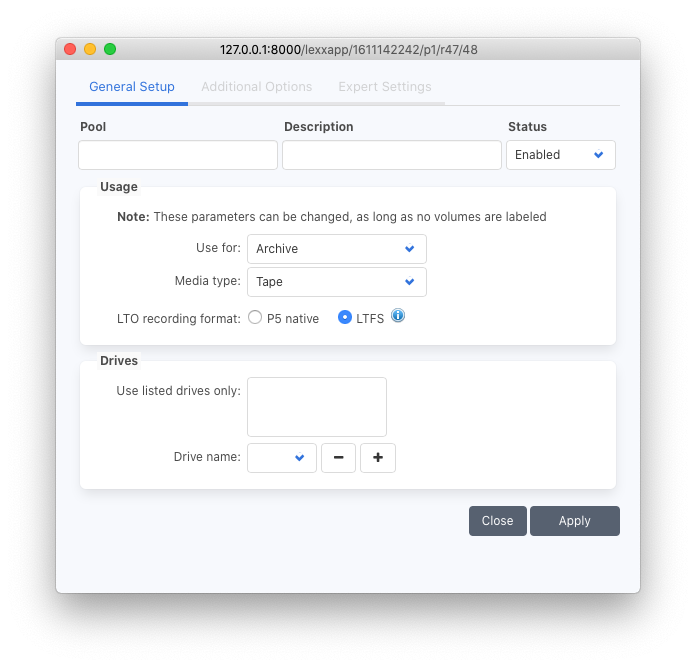
Archiware's cross-platform LTFS driver that brings features and convenience not seen before with LTFS software products. This new approach removes the need for the open-source 'FUSE' software used by competitive products, allowing direct control of the tape media, while maintaining full ISO/IEC compatibility.
LTFS formatted LTO tapes are now supported by the P5 Archive module. Users wishing to archive data to tape, with full indexing, searching, thumbnail generation and meta-data ingest, can now choose between two different tape formats.
Both formats support spanning of large files across tapes. When a storage pool is created for archiving, there is now an option to choose between the 'P5 Native' and LTFS formats. Volumes can be formatted as LTFS by labelling, in single drives or libraries.
Existing native pools and LTO volumes will continue to work in combination with LTFS volumes. P5 Volume format continues to be the recommended option for P5 Archive. LTFS is a useful option where interoperability with non-Archiware systems is required.
P5 volume format
- Supported for 20 years across thousands of P5 installations, compatibility across all P5 supported platforms, support for block-level cloning, parallel writing across multiple tape drives, data-compression/encryption and free from character set limitations for file/folder names.
LTFS volume format
- Open standard (ISO/IEC 20919:2016) and manufacturer-independent tape format, compatible across all P5 supported platforms (macOS, Windows, Linux, FreeBSD) and also with other LTFS software tools for software-independent restore of data.
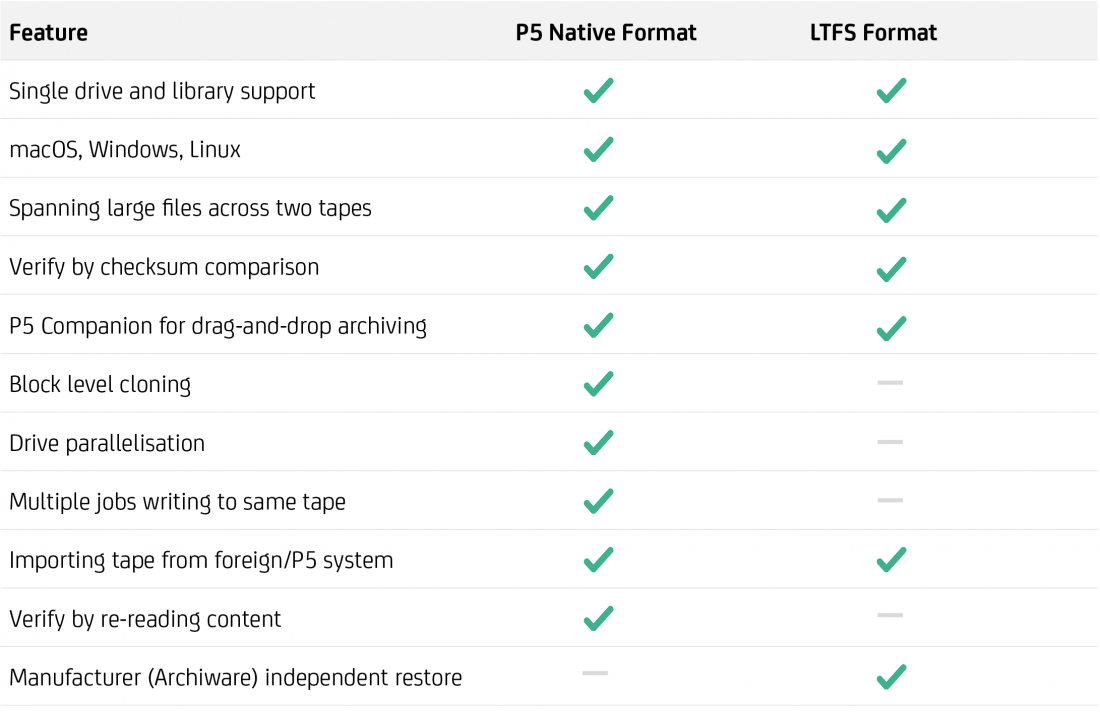
Cost of Tape vs. Disk RAID

Clone Tapes to keep one copy offsite. Parallelize to achieve maximum throughput.
SOFTWARE HIGHLIGHTS
- Migrate server data
- To disk, tape or cloud
- EDL restore
- Previews and metadata
- Drive parallelization
- Tape cloning
- Offsite storage
TECHNICAL FEATURES
- Data migration
- Full or incremental
- Preview creation
- User-definable Metadata
- File filter/policies
- Data restore between platforms
OS SERVER & CLIENT
- macOS Server
- macOS
- Windows
- Linux
- QNAP
- Synology
- ReadyNAS
- TrueNAS
FILE SERVER
- ExtremeZ-IP
- Helios
- Xinet
- Netatalk
Read more about the System Requirements and Compatibilities for P5 Archive.
Contact
Pre-sales/Technical:
Archiware Support
Sales/Licensing:
team@archiware.com
(Please take note of our sales policy
when requesting pricing or quotes)

